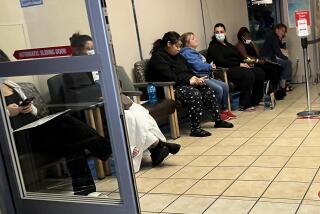Ethnicity Discrepancy Found in Patients in HIV Trials
- Share via
Black and Latino HIV patients are enrolling in experimental treatments at much lower rates than whites, according to a national study published Thursday in the New England Journal of Medicine.
Researchers say the disparity is caused by minorities’ mistrust of experimental treatments and lack of access to university health facilities.
Those experimental HIV treatments may be the last hope for patients who fail to respond to retroviral drugs, said Dr. Allen Gifford, lead author of the study.
As a result, “being able to entertain the option of experimental care is important,” said Gifford, a physician and researcher at the Veterans Affairs San Diego Healthcare System.
The study did not track whether patients enrolled in the experiments had exhausted other more mainstream options.
Gifford’s team analyzed data from a Rand Corp.-sponsored study of 2,864 HIV patients receiving care across the country from 1996 to 1998.
At the study’s outset, 49% of the 231,000 Americans receiving any type of HIV treatment were white, 33% were black and 15% were Latino.
Of those enrolled in trials, however, 62% were white, 23% were black and 11% were Latino, even if whites and minorities had similar education, type of health insurance and degree of illness.
Although the study did not survey patients about the cause of the discrepancy, researchers stressed that access to the experiments plays a role. Many university centers providing treatment are not near ethnic neighborhoods, said Gail Wyatt, associate director of the UCLA AIDS Institute.
Also, African Americans may associate experimental therapies with the notorious Tuskegee Syphilis Experiment. From 1932 to 1972, Alabama doctors lied to poor black patients, studying the disease when left untreated.
“They have a reason to start from a position of suspiciousness,” Wyatt said.
It is customary for contemporary medical researchers to provide consent forms with as many as 10 pages, but that may backfire, said Susan Cohn, AIDS researcher and associate professor of medicine at the University of Rochester in New York. “People may be more turned off than not,” she said. “There’s a wariness on the part of patients.”
The study also found that patients with fee-for-service health insurance were more likely than those in HMOs to receive experimental treatment, as were subjects whose primary-care physician is fewer than eight miles from a major clinical trial center.
The study also looked at gender and found that women were enrolled in the experiments at rates comparable to their overall rate of HIV treatment, Gifford said. In recent years, researchers have made a special effort to recruit women who may infect their babies in utero.






